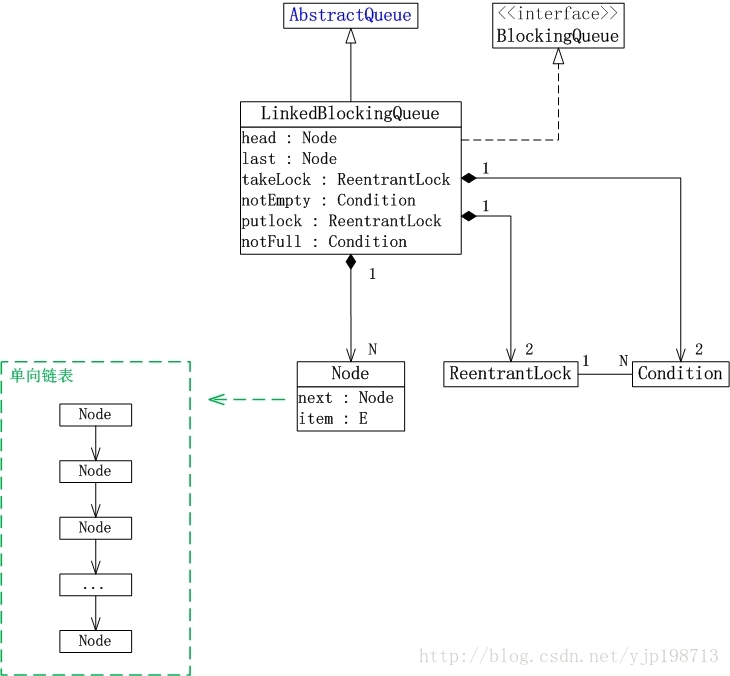一、LinkedBlockingQueue介绍
LinkedBlockingQueue是一个单向链表实现的阻塞队列。该队列按 FIFO(先进先出)排序元素,新元素插入到队列的尾部,并且队列获取操作会获得位于队列头部的元素。链接队列的吞吐量通常要高于基于数组的队列,但是在大多数并发应用程序中,其可预知的性能要低。
此外,LinkedBlockingQueue还是可选容量的(防止过度膨胀),即可以指定队列的容量。如果不指定,默认容量大小等于Integer.MAX_VALUE。
二、LinkedBlockingQueue原理和数据结构

说明:
- LinkedBlockingQueue继承于AbstractQueue,它本质上是一个FIFO(先进先出)的队列。
- LinkedBlockingQueue实现了BlockingQueue接口,它支持多线程并发。当多线程竞争同一个资源时,某线程获取到该资源之后,其它线程需要阻塞等待。
- LinkedBlockingQueue是通过单链表实现的。
(01) head是链表的表头。取出数据时,都是从表头head处取出。
(02) last是链表的表尾。新增数据时,都是从表尾last处插入。
(03) count是链表的实际大小,即当前链表中包含的节点个数。
(04) capacity是列表的容量,它是在创建链表时指定的。
(05) putLock是插入锁,takeLock是取出锁;notEmpty是“非空条件”,notFull是“未满条件”。通过它们对链表进行并发控制。
LinkedBlockingQueue在实现“多线程对竞争资源的互斥访问”时,对于“插入”和“取出(删除)”操作分别使用了不同的锁。对于插入操作,通过“插入锁putLock”进行同步;对于取出操作,通过“取出锁takeLock”进行同步。
此外,插入锁putLock和“非满条件notFull”相关联,取出锁takeLock和“非空条件notEmpty”相关联。通过notFull和notEmpty更细腻的控制锁。
a、若某线程(线程A)要取出数据时,队列正好为空,则该线程会执行notEmpty.await()进行等待;当其它某个线程(线程B)向队列中插入了数据之后,会调用notEmpty.signal()唤醒“notEmpty上的等待线程”。此时,线程A会被唤醒从而得以继续运行。 此外,线程A在执行取操作前,会获取takeLock,在取操作执行完毕再释放takeLock。
b、 若某线程(线程H)要插入数据时,队列已满,则该线程会它执行notFull.await()进行等待;当其它某个线程(线程I)取出数据之后,会调用notFull.signal()唤醒“notFull上的等待线程”。此时,线程H就会被唤醒从而得以继续运行。 此外,线程H在执行插入操作前,会获取putLock,在插入操作执行完毕才释放putLock。
三、LinkedBlockingQueue函数列表
// 创建一个容量为 Integer.MAX_VALUE 的 LinkedBlockingQueue。
LinkedBlockingQueue()
// 创建一个容量是 Integer.MAX_VALUE 的 LinkedBlockingQueue,最初包含给定 collection 的元素,元素按该 collection 迭代器的遍历顺序添加。
LinkedBlockingQueue(Collection<? extends E> c)
// 创建一个具有给定(固定)容量的 LinkedBlockingQueue。
LinkedBlockingQueue(int capacity)
// 从队列彻底移除所有元素。
void clear()
// 移除此队列中所有可用的元素,并将它们添加到给定 collection 中。
int drainTo(Collection<? super E> c)
// 最多从此队列中移除给定数量的可用元素,并将这些元素添加到给定 collection 中。
int drainTo(Collection<? super E> c, int maxElements)
// 返回在队列中的元素上按适当顺序进行迭代的迭代器。
Iterator<E> iterator()
// 将指定元素插入到此队列的尾部(如果立即可行且不会超出此队列的容量),在成功时返回 true,如果此队列已满,则返回 false。
boolean offer(E e)
// 将指定元素插入到此队列的尾部,如有必要,则等待指定的时间以使空间变得可用。
boolean offer(E e, long timeout, TimeUnit unit)
// 获取但不移除此队列的头;如果此队列为空,则返回 null。
E peek()
// 获取并移除此队列的头,如果此队列为空,则返回 null。
E poll()
// 获取并移除此队列的头部,在指定的等待时间前等待可用的元素(如果有必要)。
E poll(long timeout, TimeUnit unit)
// 将指定元素插入到此队列的尾部,如有必要,则等待空间变得可用。
void put(E e)
// 返回理想情况下(没有内存和资源约束)此队列可接受并且不会被阻塞的附加元素数量。
int remainingCapacity()
// 从此队列移除指定元素的单个实例(如果存在)。
boolean remove(Object o)
// 返回队列中的元素个数。
int size()
// 获取并移除此队列的头部,在元素变得可用之前一直等待(如果有必要)。
E take()
// 返回按适当顺序包含此队列中所有元素的数组。
Object[] toArray()
// 返回按适当顺序包含此队列中所有元素的数组;返回数组的运行时类型是指定数组的运行时类型。
<T> T[] toArray(T[] a)
// 返回此 collection 的字符串表示形式。
String toString()
四、LinkedBlockingQueue源码分析
1. 创建
下面以LinkedBlockingQueue(int capacity)来进行说明。
public LinkedBlockingQueue(int capacity) {
if (capacity <= 0) throw new IllegalArgumentException();
this.capacity = capacity;
last = head = new Node<E>(null);
}
说明:
(01) capacity是“链式阻塞队列”的容量。
(02) head和last是“链式阻塞队列”的首节点和尾节点。它们在LinkedBlockingQueue中的声明如下:
// 容量
private final int capacity;
// 当前数量
private final AtomicInteger count = new AtomicInteger(0);
private transient Node<E> head; // 链表的表头
private transient Node<E> last; // 链表的表尾
// 用于控制“删除元素”的互斥锁takeLock 和 锁对应的“非空条件”notEmpty
private final ReentrantLock takeLock = new ReentrantLock();
private final Condition notEmpty = takeLock.newCondition();
// 用于控制“添加元素”的互斥锁putLock 和 锁对应的“非满条件”notFull
private final ReentrantLock putLock = new ReentrantLock();
private final Condition notFull = putLock.newCondition();
链表的节点定义如下:
static class Node<E> {
E item; // 数据
Node<E> next; // 下一个节点的指针
Node(E x) { item = x; }
}
2. 添加
下面以offer(E e)为例,对LinkedBlockingQueue的添加方法进行说明。
public boolean offer(E e) {
if (e == null) throw new NullPointerException();
// 如果“队列已满”,则返回false,表示插入失败。
final AtomicInteger count = this.count;
if (count.get() == capacity)
return false;
int c = -1;
// 新建“节点e”
Node<E> node = new Node(e);
final ReentrantLock putLock = this.putLock;
// 获取“插入锁putLock”
putLock.lock();
try {
// 再次对“队列是不是满”的进行判断。
// 若“队列未满”,则插入节点。
if (count.get() < capacity) {
// 插入节点
enqueue(node);
// 将“当前节点数量”+1,并返回“原始的数量”
c = count.getAndIncrement();
// 如果在插入元素之后,队列仍然未满,则唤醒notFull上的等待线程。
if (c + 1 < capacity)
notFull.signal();
}
} finally {
// 释放“插入锁putLock”
putLock.unlock();
}
// 如果在插入节点前,队列为空;则插入节点后,唤醒notEmpty上的等待线程
if (c == 0)
signalNotEmpty();
return c >= 0;
}
说明:offer()的作用很简单,就是将元素E添加到队列的末尾。
enqueue()的源码如下:
private void enqueue(Node<E> node) {
// assert putLock.isHeldByCurrentThread();
// assert last.next == null;
last = last.next = node;
}
enqueue()的作用是将node添加到队列末尾,并设置node为新的尾节点!
signalNotEmpty()的源码如下:
private void signalNotEmpty() {
final ReentrantLock takeLock = this.takeLock;
takeLock.lock();
try {
notEmpty.signal();
} finally {
takeLock.unlock();
}
}
signalNotEmpty()的作用是唤醒notEmpty上的等待线程。
3. 取出
下面以take()为例,对LinkedBlockingQueue的取出方法进行说明。
public E take() throws InterruptedException {
E x;
int c = -1;
final AtomicInteger count = this.count;
final ReentrantLock takeLock = this.takeLock;
// 获取“取出锁”,若当前线程是中断状态,则抛出InterruptedException异常
takeLock.lockInterruptibly();
try {
// 若“队列为空”,则一直等待。
while (count.get() == 0) {
notEmpty.await();
}
// 取出元素
x = dequeue();
// 取出元素之后,将“节点数量”-1;并返回“原始的节点数量”。
c = count.getAndDecrement();
if (c > 1)
notEmpty.signal();
} finally {
// 释放“取出锁”
takeLock.unlock();
}
// 如果在“取出元素之前”,队列是满的;则在取出元素之后,唤醒notFull上的等待线程。
if (c == capacity)
signalNotFull();
return x;
}
说明:take()的作用是取出并返回队列的头。若队列为空,则一直等待。
dequeue()的源码如下:
private E dequeue() {
// assert takeLock.isHeldByCurrentThread();
// assert head.item == null;
Node<E> h = head;
Node<E> first = h.next;
h.next = h; // help GC
head = first;
E x = first.item;
first.item = null;
return x;
}
dequeue()的作用就是删除队列的头节点,并将表头指向“原头节点的下一个节点”。
signalNotFull()的源码如下:
private void signalNotFull() {
final ReentrantLock putLock = this.putLock;
putLock.lock();
try {
notFull.signal();
} finally {
putLock.unlock();
}
}
signalNotFull()的作用就是唤醒notFull上的等待线程。
4. 遍历
下面对LinkedBlockingQueue的遍历方法进行说明。
public Iterator<E> iterator() {
return new Itr();
}
iterator()实际上是返回一个Iter对象。
Itr类的定义如下:
private class Itr implements Iterator<E> {
// 当前节点
private Node<E> current;
// 上一次返回的节点
private Node<E> lastRet;
// 当前节点对应的值
private E currentElement;
Itr() {
// 同时获取“插入锁putLock” 和 “取出锁takeLock”
fullyLock();
try {
// 设置“当前元素”为“队列表头的下一节点”,即为队列的第一个有效节点
current = head.next;
if (current != null)
currentElement = current.item;
} finally {
// 释放“插入锁putLock” 和 “取出锁takeLock”
fullyUnlock();
}
}
// 返回“下一个节点是否为null”
public boolean hasNext() {
return current != null;
}
private Node<E> nextNode(Node<E> p) {
for (;;) {
Node<E> s = p.next;
if (s == p)
return head.next;
if (s == null || s.item != null)
return s;
p = s;
}
}
// 返回下一个节点
public E next() {
fullyLock();
try {
if (current == null)
throw new NoSuchElementException();
E x = currentElement;
lastRet = current;
current = nextNode(current);
currentElement = (current == null) ? null : current.item;
return x;
} finally {
fullyUnlock();
}
}
// 删除下一个节点
public void remove() {
if (lastRet == null)
throw new IllegalStateException();
fullyLock();
try {
Node<E> node = lastRet;
lastRet = null;
for (Node<E> trail = head, p = trail.next;
p != null;
trail = p, p = p.next) {
if (p == node) {
unlink(p, trail);
break;
}
}
} finally {
fullyUnlock();
}
}
}
Java 面试宝典是大明哥全力打造的 Java 精品面试题,它是一份靠谱、强大、详细、经典的 Java 后端面试宝典。它不仅仅只是一道道面试题,而是一套完整的 Java 知识体系,一套你 Java 知识点的扫盲贴。
它的内容包括:
- 大厂真题:Java 面试宝典里面的题目都是最近几年的高频的大厂面试真题。
- 原创内容:Java 面试宝典内容全部都是大明哥原创,内容全面且通俗易懂,回答部分可以直接作为面试回答内容。
- 持续更新:一次购买,永久有效。大明哥会持续更新 3+ 年,累计更新 1000+,宝典会不断迭代更新,保证最新、最全面。
- 覆盖全面:本宝典累计更新 1000+,从 Java 入门到 Java 架构的高频面试题,实现 360° 全覆盖。
- 不止面试:内容包含面试题解析、内容详解、知识扩展,它不仅仅只是一份面试题,更是一套完整的 Java 知识体系。
- 宝典详情:https://www.yuque.com/chenssy/sike-java/xvlo920axlp7sf4k
- 宝典总览:https://www.yuque.com/chenssy/sike-java/yogsehzntzgp4ly1
- 宝典进展:https://www.yuque.com/chenssy/sike-java/en9ned7loo47z5aw
目前 Java 面试宝典累计更新 400+ 道,总字数 42w+。大明哥还在持续更新中,下图是大明哥在 2024-12 月份的更新情况:

想了解详情的小伙伴,扫描下面二维码加大明哥微信【daming091】咨询

同时,大明哥也整理一套目前市面最常见的热点面试题。微信搜[大明哥聊 Java]或扫描下方二维码关注大明哥的原创公众号[大明哥聊 Java] ,回复【面试题】 即可免费领取。

